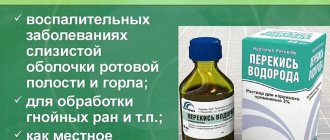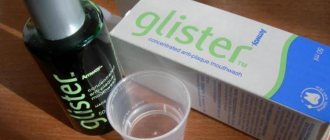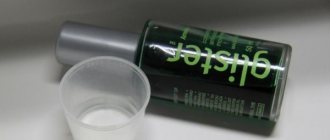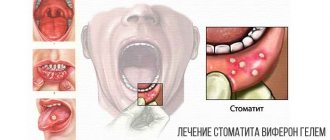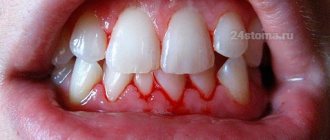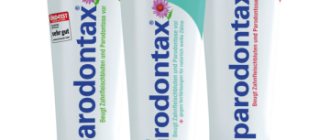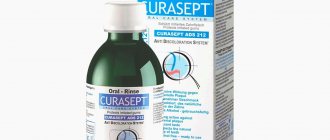Toothache inevitably causes serious discomfort. During the treatment of dental diseases, acute discomfort intensifies, since additional manipulations in the oral cavity greatly intensify the already painful condition.
To make the treatment process easy and painless for the patient, specialists use various types of anesthetics. Lidocaine spray for toothache is one such remedy, widely used for local anesthesia.
However, this remedy can also be used at home to reduce pain. True, it is better to do this under the supervision of a specialist.
Need for use
According to its chemical properties, lidocaine is an amide-type drug. When compared with other common anesthetics, we can talk about an average degree of pain relief. According to reviews of lidocaine spray for toothache, the effect of this drug is several times stronger than the effect of the commonly used novocaine.
Marina, 35 years old, review from a thematic forum:
“Numbness is the feeling I get when it comes to dental treatment. I have had an overwhelming fear of the dentist's office since childhood. Therefore, I still dread going to the dentist, but lidocaine spray personally helps me a lot. My dentist first numbs the injection site and only then inserts the needle, but I no longer feel anything. It's a pity that there weren't such resources when I was a child. It would fix a lot of things."
When spraying the product, a person experiences a complete loss of sensitivity in the treated area. Lidocaine spray for toothache blocks nerve signals that enter the brain. In this case, the patient calms down, his emotional state normalizes, and the doctor gets the opportunity to carry out a set of manipulations necessary to treat a dental disease.
At home, the spray can be used in case of inflammation of the gums, toothache, stomatitis or ulcers on the mucous membranes. True, the drug provides only temporary pain relief, so you should still consult a doctor to resolve the issue.
Important! Lidocaine is one of the most allergic pain relievers. Therefore, before using it, it is worth conducting a test - applying a small amount of the drug to the skin and assessing whether there is a rash.
How does lidocaine work?
Lidocaine is a topical agent. In addition to the analgesic effect, the drug helps normalize the heartbeat and generally has a calming effect. The action of the active components of the drug is aimed at blocking the conduction of nerve endings and fibers.
The painkiller helps dilate blood vessels. However, this is not a very good advantage. Modern anesthetics, on the contrary, have vasoconstrictor properties, so the anesthesia acts locally, while lidocaine spreads throughout the body. That is why it is not recommended for use in case of heart pathologies, during pregnancy and breastfeeding.
Lidocaine
The toxicity of lidocaine increases when it is used simultaneously with cimetidine and propranolol due to an increase in the concentration of lidocaine; this requires a reduction in the dose of lidocaine. Both drugs reduce hepatic blood flow. In addition, cimetidine inhibits the microsomal activity of liver enzymes.
Ranitidine, Diltiazem, verapamil, propranolol and other β-blockers reduce the clearance of lidocaine, which leads to an increase in its concentration in the blood plasma.
Antiviral agents (eg, amprenavir, atazanavir, darunavir, lopinavir) can also cause increased serum concentrations of lidocaine.
Hypokalemia caused by diuretics may reduce the effect of lidocaine when used simultaneously (see section "Special Instructions"). Lidocaine should be used with caution in patients receiving other local anesthetics or agents structurally similar to amide-type local anesthetics (eg, antiarrhythmic agents such as mexiletine, tocainide) because systemic toxic effects are additive.
When lidocaine is used in combination with narcotic analgesics, hexenal or sodium thiopental, the inhibitory effect on the central nervous system and respiration may be enhanced.
Separate drug interaction studies have not been conducted between lidocaine and class III antiarrhythmic drugs (eg, amiodarone), but caution is recommended when using them together.
In patients concomitantly receiving antipsychotics that prolong or have the potential to prolong the QT interval (e.g., pimozide, sertindole, olanzapine, quetiapine, zotepine), prenylamine, epinephrine (with occasional intravenous administration), or 5-HT3-serotonin receptor antagonists (e.g., tropisetron, dolasetron), the risk of developing ventricular arrhythmias may increase.
Concomitant use of quinupristin/dalfopristin may increase lidocaine concentrations and thus increase the risk of developing ventricular arrhythmias; their simultaneous use should be avoided.
Patients receiving muscle relaxants (eg, suxamethonium) may have an increased risk of enhanced and prolonged neuromuscular blockade.
Cardiovascular insufficiency has been reported following the use of bupivacaine in patients receiving verapamil and timolol; lidocaine is similar in structure to bupivacaine.
Dopamine and 5-hydroxytryptamine lower the seizure threshold in patients receiving lidocaine.
Opioids appear to have anticonvulsant effects, supported by evidence that lidocaine lowers the seizure threshold to fentanyl in humans.
Combinations of opioids and antiemetics, sometimes used for sedation in children, may lower the seizure threshold to lidocaine and increase its CNS depressant effects.
The use of epinephrine with lidocaine may reduce systemic absorption, but with accidental intravenous administration the risk of ventricular tachycardia and ventricular fibrillation increases sharply.
Concomitant use of other antiarrhythmic drugs, beta-blockers and slow calcium channel blockers may further reduce AV conduction, ventricular conduction and myocardial contractility.
The simultaneous use of vasoconstrictors increases the duration of action of lidocaine.
Concomitant use of lidocaine and ergot alkaloids (eg, ergotamine) can cause severe hypotension.
Caution must be exercised when using sedatives as they may interfere with the action of local anesthetics on the central nervous system. Caution should be exercised when using antiepileptic drugs (phenytoin), barbiturates and other inhibitors of liver microsomal enzymes, as this may lead to decreased effectiveness and, as a result, an increased need for lidocaine. On the other hand, intravenous administration of phenytoin may enhance the depressant effect of lidocaine on the heart.
The analgesic effect of local anesthetics can be enhanced by opioids and clonidine.
The combined use of lidocaine with procainamide can cause central nervous system stimulation and hallucinations.
When using lidocaine and polymyxin-B simultaneously, it is necessary to monitor the patient's respiratory function. Ethyl alcohol, especially with prolonged abuse, can reduce the effect of local anesthetics. Lidocaine is not compatible with amphotericin B, methohexitone, nitroglycerin.
With the simultaneous use of lidocaine with narcotic analgesics, an additive effect develops, which is used during epidural anesthesia, but increases the depression of the central nervous system and respiration.
Vasoconstrictors (epinephrine, methoxamine, phenylephrine) prolong the local anesthetic effect of lidocaine and can cause increased blood pressure and tachycardia.
Use with monoamine oxidase inhibitors (furazolidone, procarbazine, selegipine) probably enhances the local anesthetic effect of lidocaine and increases the risk of lowering blood pressure. Guanadrel, guanethidine, mecamylamine, grimstaphane camsylate increase the risk of a pronounced decrease in blood pressure and bradycardia. Anticoagulants (including ardeparin sodium, dalteparin sodium, danaparoid sodium, enoxaparin sodium, heparin, warfarin, etc.), nonsteroidal anti-inflammatory drugs (NSAIDs) or plasma expanders increase the risk of bleeding.
Lidocaine reduces the cardiotonic effect of digitoxin.
Lidocaine reduces the effect of antimyasthenic drugs (prozerin, oxazil, etc.), enhances and prolongs the effect of muscle relaxant drugs.
When treating the injection site with disinfectant solutions containing heavy metals, the risk of developing a local reaction in the form of pain and swelling increases.
Mixing lidocaine with other medications is not recommended.
How to use lidocaine spray for toothache
Lidocaine spray has a 10% concentration of active ingredients, due to which the painkiller acts almost instantly. The effect occurs within a minute after using the spray. However, the duration of action is only 5-6 minutes. Therefore, in dentistry it is often used for superficial anesthesia.
For pain relief, three presses on the bottle button are enough. If we talk about medicine in general, then the maximum number of sprays should not exceed 40 presses with a patient weighing about 70 kg. You can also apply the product to a cotton swab and apply it to the inflamed area.
Important! Immediately after spraying, the patient may notice a slight burning sensation in the area where the drug is distributed. This is not necessarily an allergic reaction - it is a normal consequence of using the drug.
Lidocaine can be purchased at a pharmacy and you do not need a prescription from your doctor. The cost of the spray varies from 300 to 400 rubles.
LIDOCAINE
Directions for use and doses
The amount of solution and the total dose of lidocaine depends on the type of anesthesia, the nature and duration of the surgical intervention.
Method of diluting 20 mg/ml (2%) lidocaine solution to obtain a solution of the required concentration:
To prepare a 10 mg/ml (1%) lidocaine solution, you need to take 1 part of a 20 mg/ml lidocaine solution and 1 part of water for injection, i.e. mix 2 ml of 20 mg/ml lidocaine solution with 2 ml of water for injection (for a 2 ml ampoule), or mix 5 ml of 20 mg/ml lidocaine solution with 5 ml of water for injection (for a 5 ml ampoule).
To prepare a 5 mg/ml (0.5%) lidocaine solution, you need to take 1 part of a 20 mg/ml lidocaine solution and 3 parts of water for injection, i.e. mix 2 ml of 20 mg/ml lidocaine solution with 6 ml of water for injection (for a 2 ml ampoule), or mix 5 ml of 20 mg/ml lidocaine solution with 15 ml of water for injection (for a 5 ml ampoule).
To prepare a 2.5 mg/ml (0.25%) lidocaine solution, you need to take 1 part of a 20 mg/ml lidocaine solution and 7 parts of water for injection, i.e. mix 2 ml of a 20 mg/ml lidocaine solution with 14 ml of water for injection (for a 2 ml ampoule), or mix 5 ml of 20 mg/ml lidocaine solution with 35 ml of water for injection (for a 5 ml ampoule).
To prepare a 1.25 mg/ml (0.125%) lidocaine solution, you need to take 1 part of a 20 mg/ml lidocaine solution and 15 parts of water for injection, i.e. mix 2 ml of a 20 mg/ml lidocaine solution with 30 ml of water for injection (for a 2 ml ampoule), or mix 5 ml of 20 mg/ml lidocaine solution with 75 ml of water for injection (for a 5 ml ampoule).
For infiltration anesthesia
(intradermal, subcutaneous) 0.125%, 0.25%, 0.5% solutions are used; to achieve infiltration anesthesia, up to 60 ml (5-300 mg) of a 0.5% solution or up to 30 ml of a 1% solution is used.
For conduction anesthesia
(anaesthesia of peripheral nerves, including blockade of nerve plexuses) use 1 and 2% solutions; the maximum total dose is up to 400 mg (40 ml of a 1% solution or 20 ml of a 2% solution). For nerve plexus blockade, 10-20 ml of a 1% solution or 5-10 ml of a 2% solution.
For conduction anesthesia of peripheral nerves
: brachial - 15-20 ml (225-300 mg) 1.5% solution; in dental practice - 1-5 ml (20-100 mg) of 2% solution; blockade of intercostal nerves - 3 ml (30 mg) of 1% solution.
For paracervical anesthesia:
10 ml (100 mg) of 1% solution in each direction, if necessary, re-administration is possible after at least 1.5 hours.
For paravertebral anesthesia
: from 3 to 5 ml (30-50 mg) of 1% solution.
Retrobulbar anesthesia -
3.0-4.0 (60-80 mg) 2% solution.
Parabulbar anesthesia
- 1.0-2.0 (20-40 mg) 2% solution.
Vagosympathetic blockade:
cervical (stellate ganglion) - 5 ml (50 mg) of 1% solution, lumbar - 5-10 ml (50-100 mg) of 1% solution.
Spinal anesthesia
- 3.0-4.0 ml (60-80 mg) 2% solution.
Epidural anesthesia -
to obtain analgesia, 25-30 ml (250-300 mg) of a 1% solution is used; to obtain anesthesia, 15-20 ml (225-300 mg) of a 1.5% solution or 10-15 ml (200-300 mg) of a 2% solution; for thoracic epidural anesthesia - 20-30 ml (200-300 mg) of 1% solution. Continuous administration of anesthetic via a catheter is not recommended; administration of the maximum dose should not be repeated more often than after 90 minutes.
When using caudal anesthesia:
in surgical practice - 15-20 ml (225-300 mg) of a 1.5% solution. Continuous administration of anesthetic via a catheter is not recommended; administration of the maximum dose should not be repeated more often than after 90 minutes. Recommended doses for children with neuromuscular blockade are up to 4.5 mg/ml of a 0.25-1.0% solution.
The maximum dose for children is 4.5 mg/kg, but not more than 100 mg; the maximum dose for adults is no more than 4.5 mg/kg or 300 mg. These doses must be repeated within 24 hours.
The effect of lidocaine can be prolonged by adding a 0.1% epinephrine solution (0.1 ml per 20 ml of lidocaine). In this case, with regional anesthesia, the dose of lidocaine can be increased to 600 mg.
Procedure for working with a polymer ampoule:
1.Take the ampoule and shake it, holding it by the neck.
2. Squeeze the ampoule with your hand, without releasing the drug, and use a rotating motion to turn and separate the valve.
3. Immediately connect the syringe to the ampoule through the resulting hole.
4. Turn the ampoule over and slowly draw its contents into the syringe.
5. Place the needle on the syringe.
Contraindications for use
The spray should not be used in children under two years of age, with a tendency to seizures, or with increased sensitivity to the components of the drug. In addition, lidocaine is contraindicated in patients with low heart rate and bronchial asthma.
In the form of local anesthesia, lidocaine is contraindicated during pregnancy, but the spray can be used. In such small dosages, the drug is unable to cause harm to either the expectant mother or the baby.
Based on materials from the website dentconsult.ru


